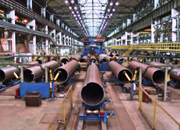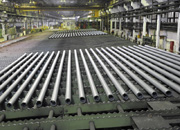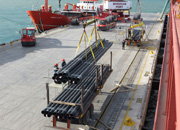09CrCuSb seamless steel pipe is a low-alloy steel material with excellent resistance to sulfuric acid dew point corrosion. It is widely used in flue gas desulfurization systems and sulfur-containing waste gas treatment equipment in industries such as power, chemical, and metallurgy. Due to its unique chemical composition and mechanical properties, this material exhibits superior service life and economic value in harsh corrosive environments, making it an important choice in environmental engineering.
From a material characteristics perspective, 09CrCuSb seamless steel pipe belongs to the low-alloy sulfuric acid dew point corrosion-resistant steel category, with a uniquely designed chemical composition. By adding alloying elements such as copper and antimony, a dense protective film is formed on the steel surface, effectively resisting corrosion from dilute sulfuric acid formed by the condensation of sulfur-containing flue gas. Compared to ordinary carbon steel, its corrosion resistance can be improved by 3-5 times, especially in sulfuric acid environments with a pH of 2-3. According to actual engineering cases, under the same working conditions, the service life of 09CrCuSb seamless steel pipe can reach 2-3 times that of ordinary carbon steel pipe, significantly reducing equipment replacement frequency and maintenance costs.
In terms of manufacturing process, 09CrCuSb seamless steel pipes are manufactured using advanced continuous casting and rolling technology. Strict control of rolling temperature and deformation ensures a uniform and dense internal structure of the steel. After hot rolling, the pipes undergo a special heat treatment process to eliminate internal stress and optimize the grain boundary structure, giving the material both good strength and toughness. Notably, this steel also possesses excellent weldability, allowing for connections using conventional welding methods. The corrosion resistance of the welded joint area is comparable to that of the base material, greatly facilitating on-site installation.
Analysis of mechanical properties shows that the tensile strength of 09CrCuSb seamless steel pipes is typically between 440-570 MPa, the yield strength is not less than 295 MPa, and the elongation remains above 22%. This good balance between strength and plasticity allows it to withstand the mechanical stresses of equipment operation while maintaining sufficient impact toughness at low temperatures. Compared to similar materials, 09CrCuSb seamless steel pipes can achieve an impact energy of over 40 J at 0℃, fully meeting the needs of most industrial applications.
In practical applications, 09CrCuSb seamless steel pipes primarily serve three major sectors: firstly, in the power industry's flue gas desulfurization systems, serving as the main structural material for absorption towers, flues, and heat exchangers; secondly, in the petrochemical industry's acid gas treatment devices, used in the manufacture of reactors and conveying pipelines; and thirdly, in metallurgical enterprises' sintering machine flue gas purification systems, undertaking the critical task of transporting corrosive media. Especially in wet desulfurization devices, this material effectively resists the synergistic corrosion effects of Cl- and F- ions, solving the technical challenges of pitting corrosion and stress corrosion cracking inherent in traditional materials.
Regarding market supply, major domestic steel companies such as Baosteel and Ansteel have the capacity for mass production of 09CrCuSb seamless steel pipes. Product specifications cover various sizes from φ10-φ1020mm, with wall thicknesses ranging from 2-50mm, meeting the needs of different engineering projects. According to procurement platform data, the market price of this material is typically 30%-50% higher than ordinary carbon steel, but considering its service life and maintenance costs, its overall life-cycle economic benefits are significant. Currently, products circulating in the market mainly comply with the GB/T 5310-2017 standard, "Seamless Steel Tubes for High-Pressure Boilers," with some exported products also conforming to international standards such as ASTM A335.
In terms of technological innovation, the research and development of 09CrCuSb seamless steel pipes in recent years has focused on three aspects: first, further optimizing the chemical composition through micro-alloying technology, such as adding trace amounts of rare earth elements to improve grain boundary corrosion resistance; second, developing new heat treatment processes, such as two-phase quenching technology, to enhance the overall performance of the material; and third, exploring surface modification technologies, such as plasma-sprayed ceramic coatings, to create a composite protective system. These technological advancements enable the new generation of 09CrCuSb seamless steel pipes to maintain stable corrosion resistance in the medium and low temperature range below 650℃.
From an engineering application perspective, several key points need to be noted during the installation and use of 09CrCuSb seamless steel pipes: the pipeline system design should avoid dead corners to prevent the accumulation of corrosive media; low-hydrogen welding rods should be used during welding, and the interpass temperature should be controlled between 150-200℃; the system should be cleaned and dried promptly when shut down to avoid static corrosion. Case studies show that after a power plant adopted 09CrCuSb seamless steel pipes in its desulfurization system, the maintenance cycle was extended from one year to three years, and annual maintenance costs decreased by more than 60%.
Compared with similar foreign products, domestically produced 09CrCuSb seamless steel pipes have a significant advantage in cost-effectiveness. Through continuous improvement, domestic products have approached international advanced levels in key performance indicators, fully meeting the needs of most industrial applications. Especially in power construction projects along the Belt and Road Initiative, Chinese-made 09CrCuSb seamless steel pipes are finding increasingly widespread application.
Looking ahead, with increasingly stringent environmental regulations and the advancement of carbon peaking and carbon neutrality goals, the market demand for 09CrCuSb seamless steel pipes will continue to grow. Industry experts predict that the demand for this material in my country's flue gas treatment sector will maintain an average annual growth rate of 8%-10% over the next five years. Simultaneously, material research and development will move towards higher corrosion resistance, easier processing, and lower costs, potentially leading to a new generation of products with corrosion resistance improvements of over 50%. The application of intelligent manufacturing technology will also improve the precision control of the production process, making product performance more stable and reliable.
In summary, 09CrCuSb seamless steel pipe, as a specialty steel product independently developed in my country, has successfully solved the material corrosion problem in industrial flue gas treatment, providing a reliable guarantee for the long-term safe operation of environmental protection facilities. With the continuous improvement of manufacturing processes and the continuous accumulation of application experience, this high-performance special steel pipe will undoubtedly demonstrate its technological and economic value in a wider range of fields, making a greater contribution to the green development of industry. When selecting a steel pipe, users should comprehensively consider factors such as the composition of corrosive media, temperature and pressure parameters, and expected service life based on specific working conditions to choose the most suitable steel pipe specifications and technical solutions.
 Threeway Steel is known as a professional supplier engaged in manufacturing and distributing a wide range of steel pipe, and our headquarter located the central part of China – Hunan and six associated factories throughout China.
Threeway Steel is known as a professional supplier engaged in manufacturing and distributing a wide range of steel pipe, and our headquarter located the central part of China – Hunan and six associated factories throughout China.
 Threeway Steel is known as a professional supplier engaged in designing, manufacturing and distribution of a wide range of steel products with the headquarter located the central part of China – Hunan and six associated factories throughout China.
Threeway Steel is known as a professional supplier engaged in designing, manufacturing and distribution of a wide range of steel products with the headquarter located the central part of China – Hunan and six associated factories throughout China.
 Threeway Steel is known as a professional supplier engaged in designing, manufacturing and distribution of a wide range of steel products with the headquarter located the central part of China – Hunan and six associated factories throughout China.
Threeway Steel is known as a professional supplier engaged in designing, manufacturing and distribution of a wide range of steel products with the headquarter located the central part of China – Hunan and six associated factories throughout China.
 Threeway Steel is known as a professional supplier engaged in designing, manufacturing and distribution of a wide range of steel products with the headquarter located the central part of China – Hunan and six associated factories throughout China.
Threeway Steel is known as a professional supplier engaged in designing, manufacturing and distribution of a wide range of steel products with the headquarter located the central part of China – Hunan and six associated factories throughout China.
 Threeway Steel is known as a professional supplier engaged in designing, manufacturing and distribution of a wide range of steel products with the headquarter located the central part of China – Hunan and six associated factories throughout China.
Threeway Steel is known as a professional supplier engaged in designing, manufacturing and distribution of a wide range of steel products with the headquarter located the central part of China – Hunan and six associated factories throughout China.

